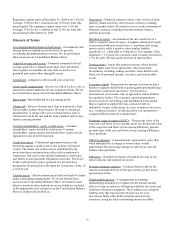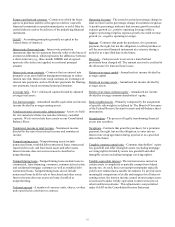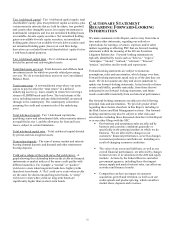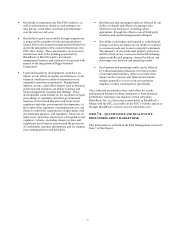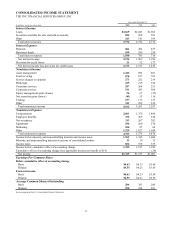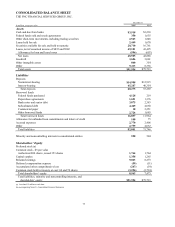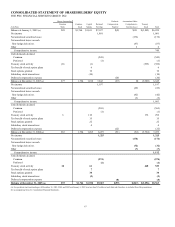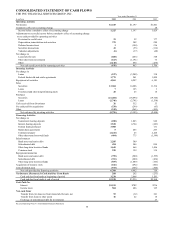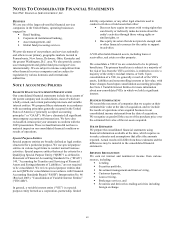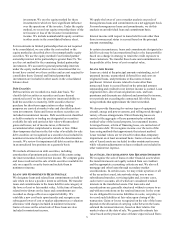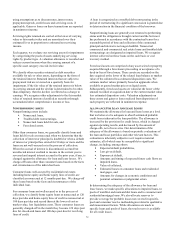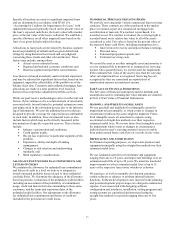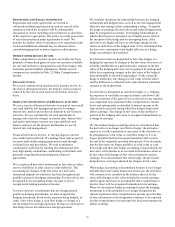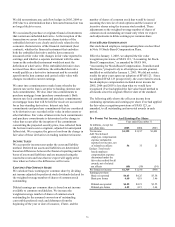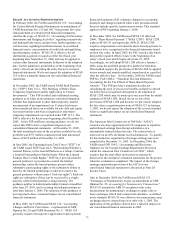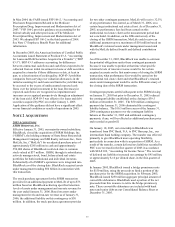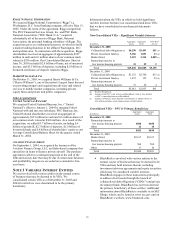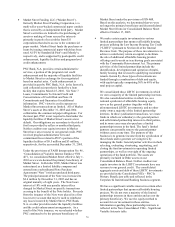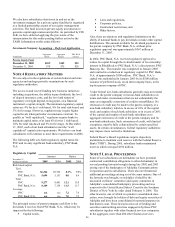PNC Bank 2005 Annual Report Download - page 70
Download and view the complete annual report
Please find page 70 of the 2005 PNC Bank annual report below. You can navigate through the pages in the report by either clicking on the pages listed below, or by using the keyword search tool below to find specific information within the annual report.70
We also earn revenue from selling loans and securities, and
we recognize income or loss from certain private equity
activities. We also earn fees and commissions from:
• Issuing loan commitments, standby letters of credit
and financial guarantees,
• Selling various insurance products,
• Providing treasury management services,
• Providing mergers and acquisitions advisory and
related services, and
• Participating in certain capital markets transactions.
We recognize revenue from loan servicing, securities and
derivatives and foreign exchange trading, and securities
underwriting activities as they are earned based on
contractual terms, as transactions occur or as services are
provided. Revenue earned on interest-earning assets is
recognized based on the effective yield of the financial
instrument. Service charges on deposit accounts are
recognized as charged. Brokerage fees and gains on the sale
of securities and certain derivatives are recognized on a
trade-date basis.
We recognize asset management and fund servicing fees
primarily as the services are performed. Asset management
fees are primarily based on a percentage of the fair value of
the assets under management and performance fees are
primarily based on a percentage of the returns on such assets.
Certain performance fees are earned upon attaining specified
investment return thresholds and are recorded as earned.
Fund servicing fees are primarily based on a percentage of
the fair value of the fund assets and the number of
shareholder accounts we service.
We recognize revenue from the sale of loans upon closing of
the transaction. We record private equity income or loss
based on changes in the valuation of the underlying
investments or when we dispose of our interest. Dividend
income from private equity investments is generally
recognized when received.
In certain circumstances, revenue is reported net of
associated expenses in accordance with applicable
accounting guidance and industry practice.
CASH AND CASH EQUIVALENTS
Cash and due from banks are considered “cash and cash
equivalents” for financial reporting purposes.
INVESTMENTS
We have interests in various types of investments. The
accounting for these investments is dependent on a number of
factors including, but not limited to, items such as:
• Marketability of the investment,
• Ownership interest,
• Our plans for the investment, and
• The nature of the investment.
Private Equity Investments
We report private equity investments, which include direct
investments in companies, interests in limited partnerships, and
affiliated partnership interests, at estimated fair values. These
estimates are based upon available information and may not
necessarily represent amounts that we will ultimately realize
through distribution, sale or liquidation of the investments. The
valuation procedures applied to direct investments include
techniques such as multiples of cash flow of the entity,
independent appraisals of the entity or the pricing used to
value the entity in a recent financing transaction. We value
affiliated partnership interests based on the underlying
investments of the partnership using procedures consistent
with those applied to direct investments. We generally value
limited partnership investments based on the financial
statements we receive from the general partner. We include all
private equity investments in the consolidated balance sheet in
other assets. Changes in the fair value of these assets are
recognized in noninterest income.
We consolidate private equity investments when we are the
sole general partner in a limited partnership and have
determined that we have control of the partnership.
Equity Securities and Partnership Interests
We account for equity investments other than private equity
investments under one of the following methods:
• Marketable equity securities are recorded on a trade-
date basis and are accounted for at fair value based on
the securities’ quoted market prices from a national
securities exchange. Dividend income on these
securities is recognized in net interest income. Those
purchased with the intention of recognizing short-
term profits are placed in the trading account, carried
at market value and classified as short-term
investments. Gains and losses on trading securities are
included in noninterest income. Marketable equity
securities not classified as trading are designated as
securities available for sale and are carried at fair
value with unrealized gains and losses, net of income
taxes, reflected in accumulated other comprehensive
income or loss. Any unrealized losses that we have
determined to be other than temporary are recognized
in the period that the determination is made.
• Investments in nonmarketable equity securities are
recorded using the cost or equity method of
accounting. The cost method is used for those
investments in which we do not have significant
influence over the investee. Under this method, there
is no change to the cost basis unless there is an other-
than-temporary decline in value. If the decline is
determined to be other than temporary, we write
down the cost basis of the investment to a new cost
basis that represents realizable value. The amount of
the write-down is accounted for as a loss included in
noninterest income in the period the determination is
made. Distributions received from income on cost
method investments are included in interest or
noninterest income depending on the type of


